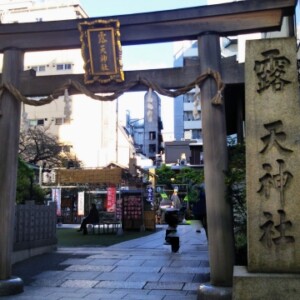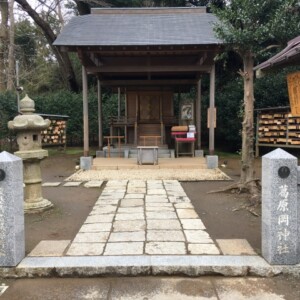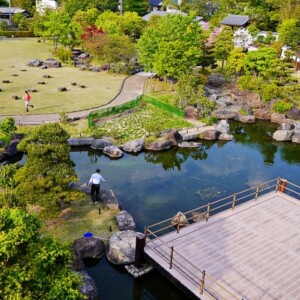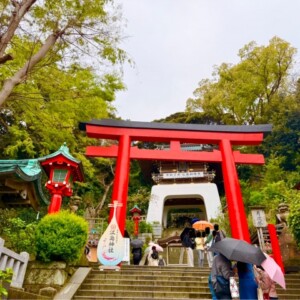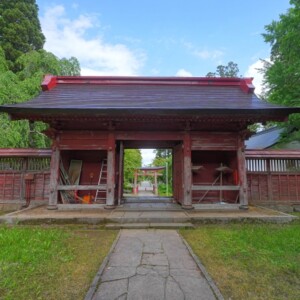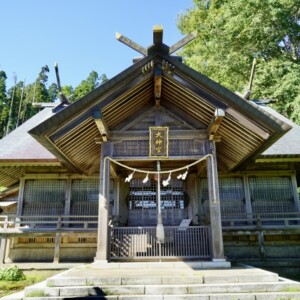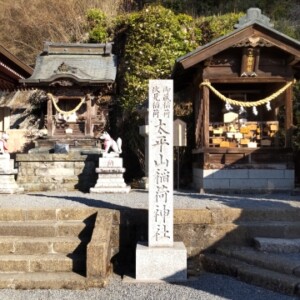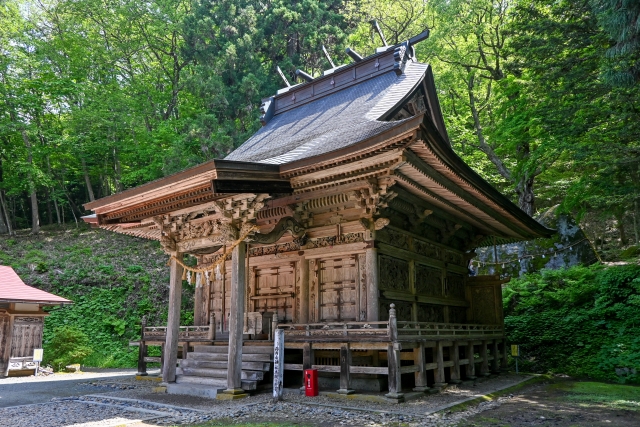
Tannaiyama Shrine|Complete guide to the history, highlights, and worship information of this historic shrine
Tannaiyama Shrine, located in Towa-cho, Hanamaki-shi, Iwate Prefecture, is a shrine with a rich history, founded in the Heian period by Nikko, a disciple of Kobo Daishi (Kukai). Mysterious legends of the Seven Wonders remain within the shrine grounds, and a giant stone of the Arahabaki Great God, a deity believed in since ancient times, is located behind the main shrine. The beautiful carvings of the main shrine, designated as a prefectural tangible cultural property, and the mysterious space created by the Tainai Stone, known as a power spot, continue to attract many worshippers.
Outline and basic information about Tannaiyama Shrine
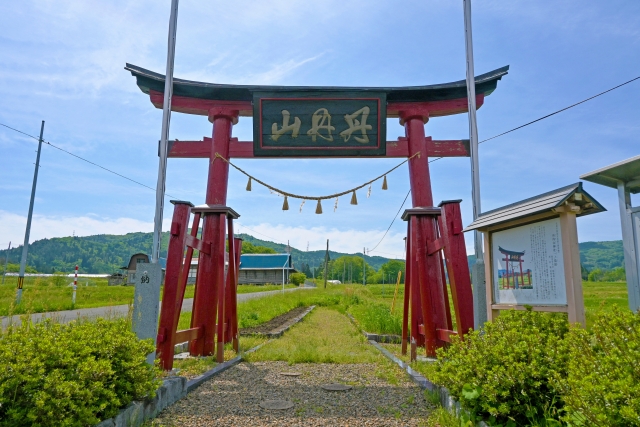
Tannaiyama Shrine, formerly called Daishoji Temple, became a shrine during the Meiji Restoration and was renamed to its current name. Located in the lush natural surroundings of Towa-machi, Hanamaki City, Iwate Prefecture, the shrine has long been beloved by the local people. The current shrine pavilion was rebuilt in 1810 and attracts many people with its beautiful architecture and rich history.
History and Origin
Tannaiyama Shrine was founded more than 1,300 years ago, when it was dedicated to the deity Taniuchi Hiko, the god who pioneered the development of this land. The shrine was founded during the Jouwa period (834-847, Heian period), when Nikko, a disciple of Kobo Daishi, enshrined Fudo Myoo. At that time, the temple was called “Daishoji Fudo Tannai Daigongen” (Daishoji Temple Fudo Tannai Daigongen).
Many historical figures have been associated with the shrine, which was rebuilt during Tamuramaro Sakagami’s expedition to the east, and it is said to have been worshipped by Minamoto no Yoriyoshi, Fujiwara no Kiyohira, the Obara clan of Yasutawara Castle, and Morioka feudal lord Nanbu no Toshitaka. The shrine was especially revered by Fujiwara no Kiyohira, and during the Edo period (1603-1867), it flourished as a place of prayer for the feudal lords of the Nanbu domain and was positioned as an important sacred site in the Tohoku region.
Interestingly, there is a legend that Sakagami Tamuramaro visited the shrine during his conquest of the East in the Enryaku era (782-805), which means that he prayed to an enemy god before the shrine was built by Hihiro. This shows that the site has long been recognized as a sacred place with strong spiritual power.
Deities and Benefits
The Tannaiyama Shrine enshrines the following very rare deities: Tanichihiko, Ama-no-Minakanushi, Takamimusubi, Kaminomusubi, Umashashikabihiko-jiko, and Husano Tsunetachi-kami (88 gods). These deities are the root of Japanese mythology. These deities are the root gods of Japanese mythology and have long been worshipped as presiding over creation and the life force.
Their benefits are diverse, including safe delivery, traffic safety, prosperous business, entrance examinations, and employment. In particular, it is said that passing through the Tainai Stone in the back of the main shrine will bring great blessings. Also enshrined within the shrine grounds is the mysterious ancient deity Arahabaki, which attracts worshippers seeking powerful powers.
Highlights and Features of Tannaiyama Shrine
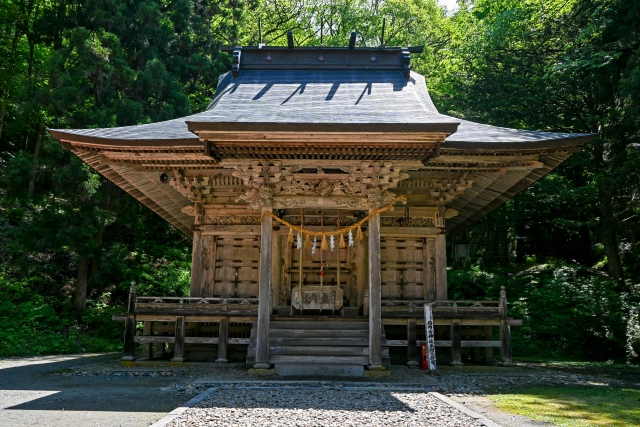
Tannaiyama Shrine is a unique combination of buildings of great historical value and mysterious natural forces. From the beautiful carvings in the main shrine, designated as a prefectural tangible cultural property, to the ancient belief in giant stones, there is a wealth of things to see and do.
Architectural and Structural Attractions
The present main hall is 6.840 m long with a beam span of 6.910 m. It is a wooden structure with an irimoya gabled roof, flat roof, copper shingle thatched roof (formerly thatched), and a clasps and gables facing the shrine. The kitchen is a ho-zukuri (three-story, three-beam, three-ken) hall with a streamlined, shingle-roofed roof with an eaves gable on the front part of the gable.
The exterior walls are decorated with carvings of Japanese and Chinese historical stories, and the side shoji (sliding door) is decorated with Chinese lions and other carvings. The colored wall carvings are by the master craftsman Chiba Yaeguro, and together with the kitchen in the main hall, are designated as a Tangible Cultural Property of the prefecture. These exquisite carvings are highly valued in architectural history as a precious cultural heritage that conveys the superior techniques of the late Edo period to the present day.
The entire building was constructed using the highest standards of technology of the time, and every detail has been meticulously decorated. When visiting the temple, visitors can take the time to appreciate these beautiful carvings and feel the craftsmen’s outstanding skills and deep devotion to their faith.
Gigantic Stone of the Great God Arahabaki (Wombstone)
At the far end of the Tannaiyama Shrine, behind the main shrine building, is a huge stone of Arahabaki, the deity of Tannaiyama Shrine. This Tainai-ishi, more than 3 m high, is the rock seat of Arahabaki, and has been enshrined as the sacred body of Tannaiyama Shrine for more than 1,300 years.
This giant rock, which was undoubtedly an object of nature worship from the Ezo and other indigenous peoples, is a single large rock with a narrow hole in it. The rock is a large rock with a narrow hole in it, and a smaller rock is leaning over the giant rock, so that visitors can pass through the hole.
It is said that if you can pass through without touching the rock, you will have a safe delivery. It is said that if you can pass through the rock without touching the wall, your great wish will be fulfilled.
The arahabaki-kami is a mysterious deity that does not appear in the Kojiki or Nihonshoki. The belief in this ancient deity has attracted the interest of many researchers and believers as a valuable example of Japan’s primitive nature worship to this day.
Legend of the Seven Wonders
Tannaiyama Shrine is known as a mysterious shrine with the legend of the “Seven Wonders,” and mystical phenomena are recounted throughout the shrine grounds. These Seven Wonders have been passed down from generation to generation by the local people as a sign of the shrine’s spiritual power.
The main hall of the shrine is said to have a legend that if one licks the Chinese lion on the side shoji of the main hall, he or she will not doze off. Another of the Seven Wonders is a rock that does not accumulate snow, and these phenomena are revered by worshippers as mysterious powers that transcend scientific explanations.
These Seven Wonders are not mere legends, but continue to be believed by many people as representing the special power that resides in the shrine. When visiting the shrine, visitors are encouraged to contemplate these wondrous phenomena as they stroll through the shrine grounds for a more profound spiritual experience.
Guide to Worship and Visiting the Shrine
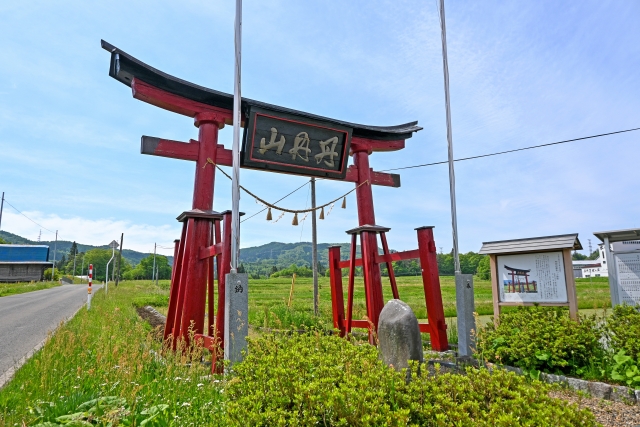
Worship at Tannaiyama Shrine allows you to experience the unique sights and power spots of this shrine while following the general etiquette of shrine worship. Please calm your mind in the tranquil precincts and take your time in this ancient and sacred space.
Worship Etiquette and Manners
Worship at the shrine begins with bowing as you pass through the torii gate. Walk down the approach to the shrine, avoiding the center of the path, and purify your body and mind at the hand-watering basin before proceeding to the main hall of the shrine. In front of the hall of worship, perform the “ni-ai ni haitai ichi-ai” (two claps, one hand, one bow) manner of worship.
At Tannai-yama Shrine, it is important to visit carefully and avoid touching the building, especially when admiring the beautiful carvings in the main shrine. Also, keep in mind that the precincts of the shrine are a sacred place, so be sure to visit the shrine quietly.
Photography is generally allowed within the shrine grounds, but please be discreet inside the main shrine building and in other areas considered sacred, and remember to be considerate of other visitors.
How to enjoy the temple as a power spot
We recommend that you take your time and experience the Gigantic Stone of the Great God Arahabaki (Tainai-ishi), the main attraction of Tannaiyama Shrine, with a recommended visit time of about 30 minutes.
Please take great care to ensure your safety while attempting to pass through the Tainai-ishi. It is quite narrow and considered difficult for an adult woman to pass through, so do not overdo it and try to worship as much as you can. Even if you cannot pass through, you can feel the power of the giant stone by simply touching it or praying in front of it.
The Seven Wonders sites located throughout the temple grounds are also popular power spots. By taking time for quiet meditation at each of these places, you will be able to feel more deeply the special energy of the shrine.
Access and Use Information
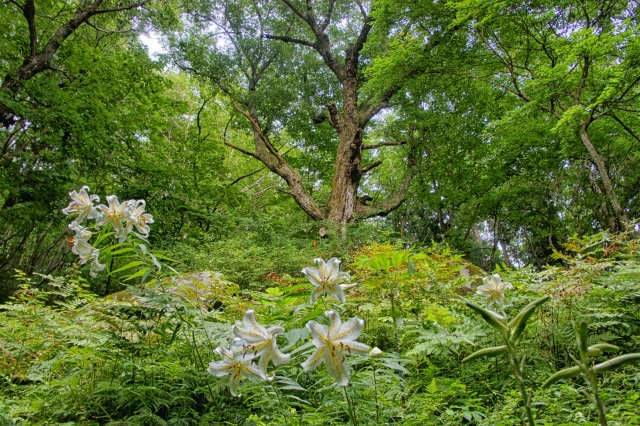
Tannaiyama Shrine is located in a rich natural setting in Towa-cho, Hanamaki City, Iwate Prefecture, and is conveniently accessible by car. If you use public transportation, you will need to make a connection, so we recommend that you plan ahead to allow plenty of time for your visit.
Transportation Access
Access by train and bus
From Tsuchizawa Station on the JR Kamaishi Line, take the Towa Kotsu Kanko Bus (Yama-no-Kami Line), get off at bus stop “Taniuchi”, and walk to the site. 25 minutes by bus from Tsuchizawa Station on the JR Kamaishi Line, get off at Unnan Bus Stop, and walk 5 minutes to the site, according to some information. The bus service is limited, so it is recommended to check the timetable in advance.
Access by Car
From the Towa IC of the Kamaishi Expressway, drive approximately 10 km via Prefectural Road 39 and Prefectural Road 284. It takes about 15 minutes from the Towa IC. This route is recommended as the paved road is considered good when entering from Prefectural Road No. 284.
It is located in the Taniuchi district, about 3 km southeast of Haruyama Station, on the north side of the road on the way to Tase Dam. The shrine needs to be entered about 400 meters from the main road.
<Address> 2-303 Taniuchi, Towa-cho, Hanamaki-shi, Iwate 028-0122
Hours of Admission, Fees, and Parking Information
Hours and Fees
Tannaiyama Shrine is open to visitors all year round. There is no admission fee, and anyone is free to visit the shrine. However, it is recommended to avoid early morning and nighttime visits for safety reasons.
Parking
There is a parking space in front of the shrine. Restrooms are available in the parking lot, but please note that the lot is closed during the winter due to icy conditions. Parking is free, but the number of spaces is limited, so please use the parking lot with a spirit of sharing during busy times.
Surrounding Area
Nearby is the former Obara Family Residence, an old form of crooked house that was converted into the Nambu crooked house, and is a National Important Cultural Property. A visit in conjunction with Tannaiyama Shrine will provide visitors with a deeper understanding of the history and culture of the area.
Reference sites
Hanamaki Tourism Association official website Tannaiyama Shrine: https://www.kanko-hanamaki.ne.jp/spot/article.php?p=157
Iwate no Tabi Tannaiyama Shrine: https://iwatetabi.jp/spots/5623/



